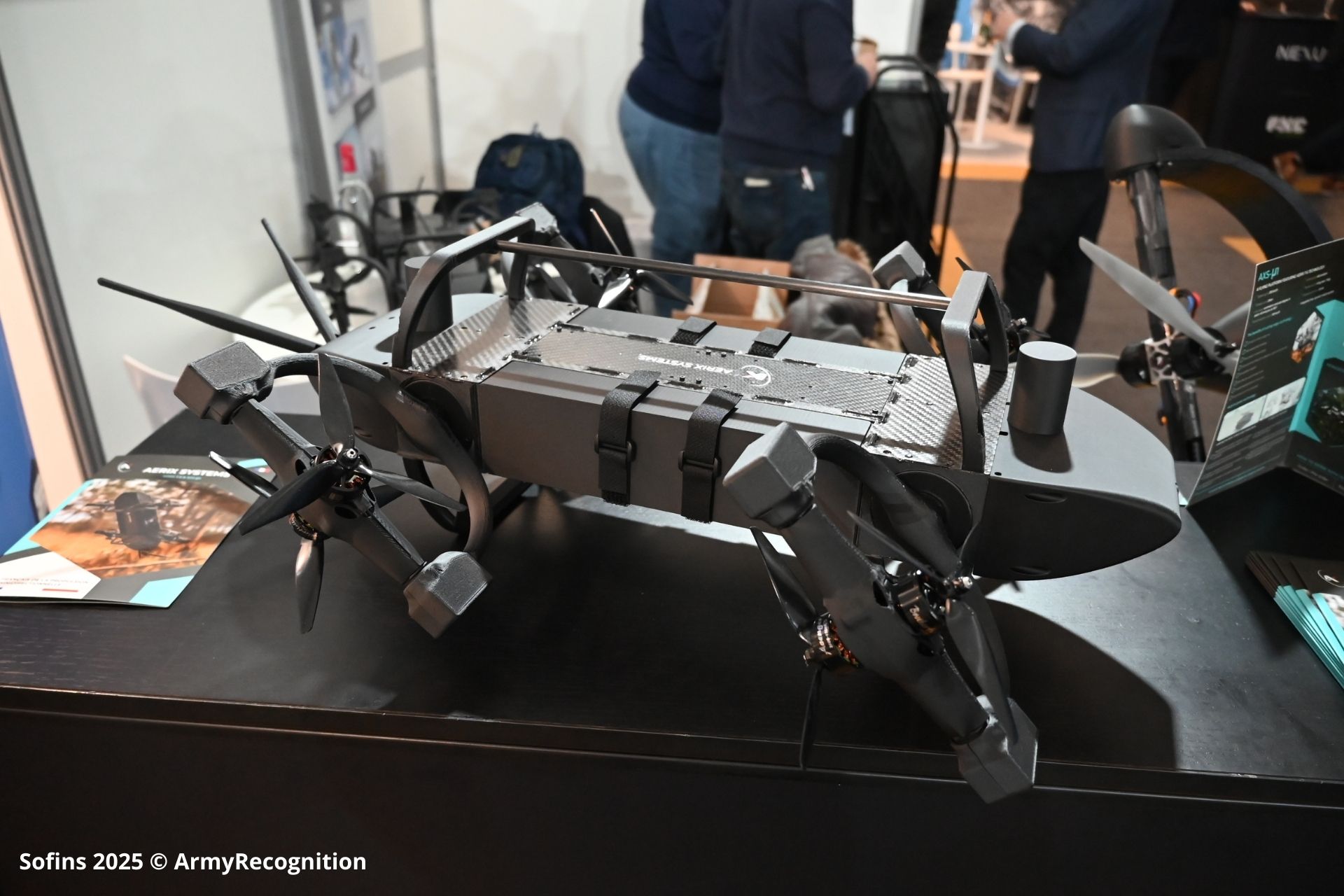Aerix Systems Launches AXS µ1 Drone with Unique Omnidirectional Capability to Engage Targets from Any Angle

{loadposition bannertop}
{loadposition sidebarpub}
On April 22, 2025, Aerix Systems officially announced the launch of its new aerial platform, the AXS-µ1. Fully developed, assembled, and tested in France, this compact drone has been designed to meet the growing demands of modern operations. With its omnidirectional propulsion system, modular architecture, and multi-domain interoperability, the AXS-µ1 is intended to provide optimal tactical agility in complex environments and can be rapidly deployed across a wide range of operational theatres.
Follow Army Recognition on Google News at this link
The system offers centimeter-level accuracy and sub-degree angular control across all three motion axes, enabling full 360-degree roll, pitch, and yaw (Picture source: Army Recognition)
The AXS-µ1 builds on technologies developed for Aerix Systems’ T-6 platform. It features high maneuverability, including the ability to fly inverted and maintain free rotation, ensuring stable performance even in strong wind conditions. Measuring 40 cm by 40 cm, the drone can reach speeds up to 200 km/h, cover distances up to 20 kilometers, and carry a payload of up to 1.5 kilograms, with 750 grams recommended for standard missions. Its operational autonomy is 15 minutes when fully equipped.
The system offers centimeter-level accuracy and sub-degree angular control across all three motion axes, enabling full 360-degree roll, pitch, and yaw. The platform includes 32 mechanical attachment points, providing a high degree of flexibility for payload integration. Electronic interfaces support a broad set of standard communication protocols (USB, UART, I2C, SPI, MIPI/CSI, Ethernet), facilitating seamless integration into existing command-and-control systems. On the software side, the AXS-µ1 grants access to navigation, control, and status data, and supports onboard artificial intelligence, computer vision, and autonomy modules. It can operate autonomously or in FPV mode and includes AI-assisted obstacle avoidance, with a plug-and-play configuration designed to minimize operator training requirements.
The drone’s versatility allows it to be configured for a wide range of mission profiles, including use as a short-range loitering munition, a micro-cruise missile for terminal strikes on fixed or mobile targets, an autonomous counter-drone interceptor, an armed aerial asset, or a system for ISTAR missions (intelligence, surveillance, target acquisition, reconnaissance). Its low detectability and ability to fly at very low altitudes make it suitable for discreet operations in urban or confined environments.
All components of the AXS-µ1, from airframe to electronics, are designed and manufactured in Bordeaux. This localized industrial control strengthens Aerix Systems’ strategic autonomy amid international supply chain tensions and increasing demand for technological self-reliance. While some marketing materials include a British flag, the company explicitly states that the technology originates in France and positions itself as a participant in both European and international markets.
Equipped with an onboard computing unit optimized for real-time inference tasks and compatible with land, sea, and air domains, the AXS-µ1 offers a modular solution aligned with evolving operational doctrines. Its compact format, integrated processing capabilities, and operational flexibility address the needs of special forces and agile units operating in increasingly contested environments.
With the official announcement of the AXS-µ1, Aerix Systems introduces a technological solution tailored to contemporary battlefield challenges. Designed to meet the requirements of current operational contexts, this compact and adaptable drone reflects France’s ongoing focus on maintaining innovation in the unmanned aerial systems sector. The first units are now ready for delivery, and demonstrations, proof-of-concept engagements, or pre-orders are available upon request for interested operators and integrators.

{loadposition bannertop}
{loadposition sidebarpub}
On April 22, 2025, Aerix Systems officially announced the launch of its new aerial platform, the AXS-µ1. Fully developed, assembled, and tested in France, this compact drone has been designed to meet the growing demands of modern operations. With its omnidirectional propulsion system, modular architecture, and multi-domain interoperability, the AXS-µ1 is intended to provide optimal tactical agility in complex environments and can be rapidly deployed across a wide range of operational theatres.
The system offers centimeter-level accuracy and sub-degree angular control across all three motion axes, enabling full 360-degree roll, pitch, and yaw (Picture source: Army Recognition)
The AXS-µ1 builds on technologies developed for Aerix Systems’ T-6 platform. It features high maneuverability, including the ability to fly inverted and maintain free rotation, ensuring stable performance even in strong wind conditions. Measuring 40 cm by 40 cm, the drone can reach speeds up to 200 km/h, cover distances up to 20 kilometers, and carry a payload of up to 1.5 kilograms, with 750 grams recommended for standard missions. Its operational autonomy is 15 minutes when fully equipped.
The system offers centimeter-level accuracy and sub-degree angular control across all three motion axes, enabling full 360-degree roll, pitch, and yaw. The platform includes 32 mechanical attachment points, providing a high degree of flexibility for payload integration. Electronic interfaces support a broad set of standard communication protocols (USB, UART, I2C, SPI, MIPI/CSI, Ethernet), facilitating seamless integration into existing command-and-control systems. On the software side, the AXS-µ1 grants access to navigation, control, and status data, and supports onboard artificial intelligence, computer vision, and autonomy modules. It can operate autonomously or in FPV mode and includes AI-assisted obstacle avoidance, with a plug-and-play configuration designed to minimize operator training requirements.
The drone’s versatility allows it to be configured for a wide range of mission profiles, including use as a short-range loitering munition, a micro-cruise missile for terminal strikes on fixed or mobile targets, an autonomous counter-drone interceptor, an armed aerial asset, or a system for ISTAR missions (intelligence, surveillance, target acquisition, reconnaissance). Its low detectability and ability to fly at very low altitudes make it suitable for discreet operations in urban or confined environments.
All components of the AXS-µ1, from airframe to electronics, are designed and manufactured in Bordeaux. This localized industrial control strengthens Aerix Systems’ strategic autonomy amid international supply chain tensions and increasing demand for technological self-reliance. While some marketing materials include a British flag, the company explicitly states that the technology originates in France and positions itself as a participant in both European and international markets.
Equipped with an onboard computing unit optimized for real-time inference tasks and compatible with land, sea, and air domains, the AXS-µ1 offers a modular solution aligned with evolving operational doctrines. Its compact format, integrated processing capabilities, and operational flexibility address the needs of special forces and agile units operating in increasingly contested environments.
With the official announcement of the AXS-µ1, Aerix Systems introduces a technological solution tailored to contemporary battlefield challenges. Designed to meet the requirements of current operational contexts, this compact and adaptable drone reflects France’s ongoing focus on maintaining innovation in the unmanned aerial systems sector. The first units are now ready for delivery, and demonstrations, proof-of-concept engagements, or pre-orders are available upon request for interested operators and integrators.




